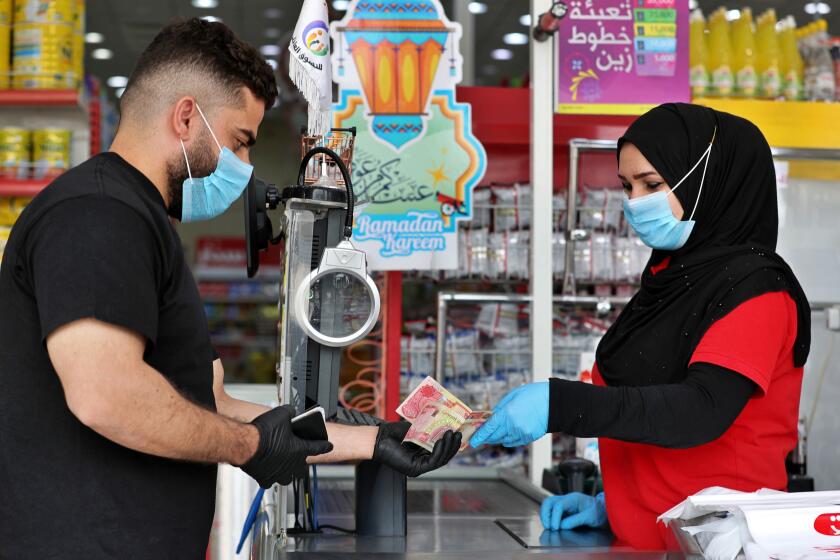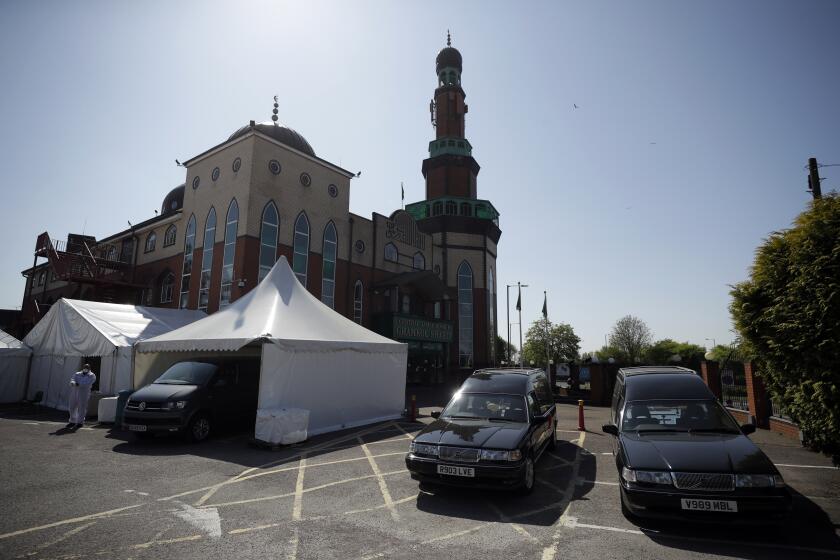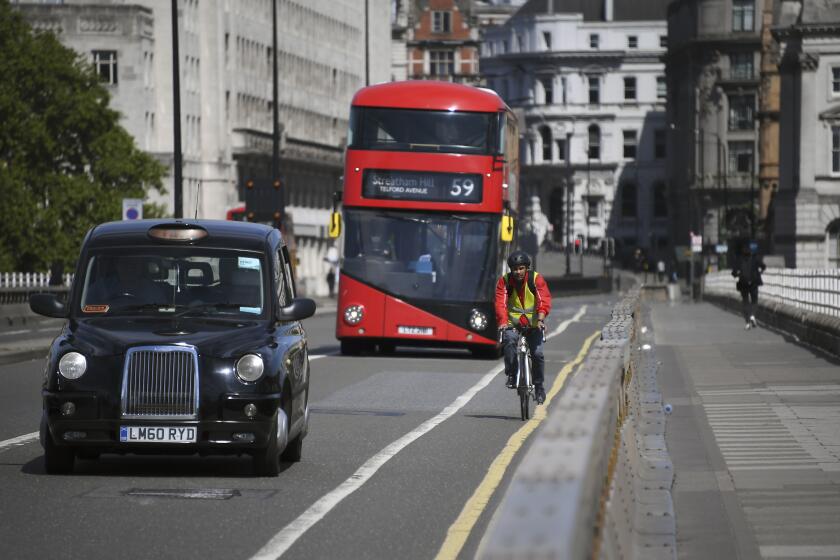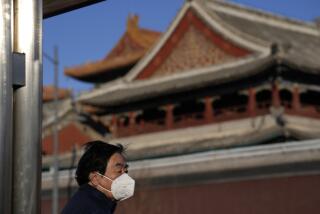Missed queues: England’s shops are back in business, and so are the lines
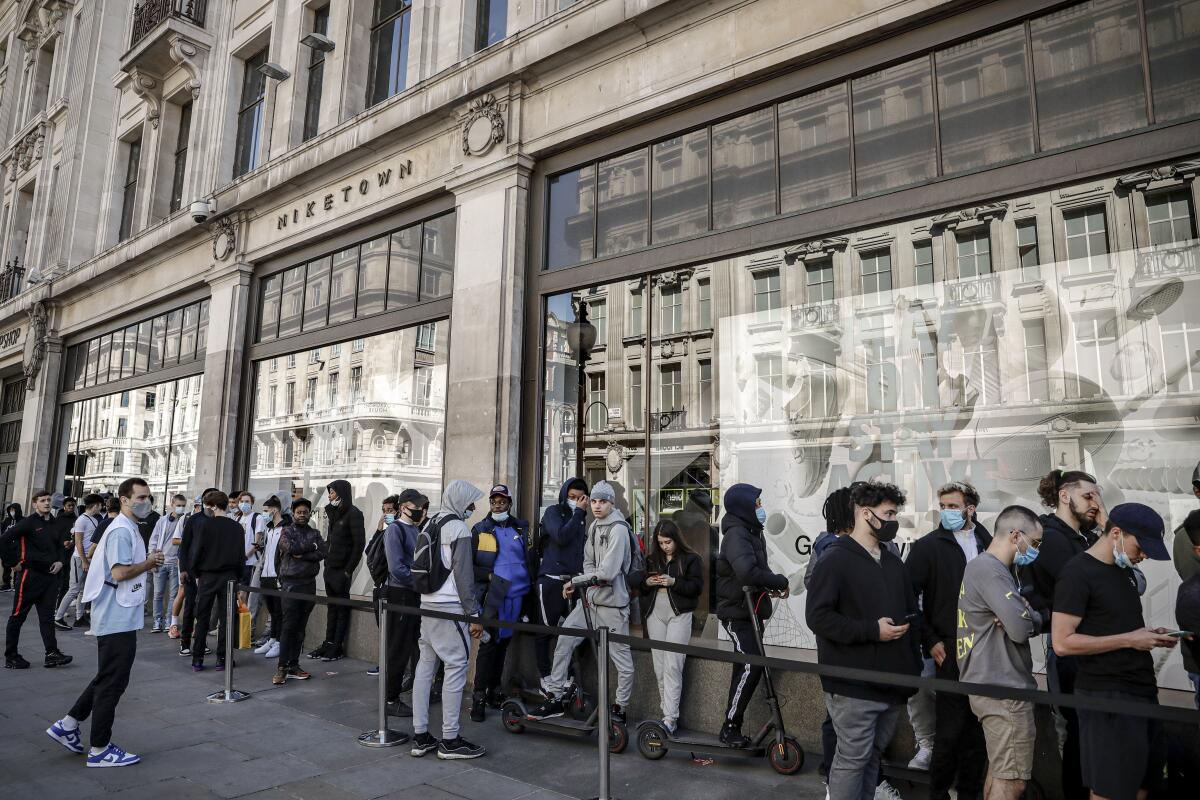
- Share via
LONDON — Long lines stretched along streets and snaked around blocks across England as shops selling fashion, toys and other nonessential items welcomed customers Monday for the first time since Britain was put into lockdown in late March.
Starved of the retail experience for the best part of three months, shoppers appeared to be obeying the social distancing requirement to stay at least six feet apart as they awaited their turn to enter the stores.
Friends Dionne Sumner and Olivia Copeland, both 25, couldn’t wait to get to their local budget clothes retailer Primark in Liverpool. Arriving at the store at 8:30 a.m., they queued for about 15 minutes before getting in.
“This has been planned, we’ve been really missing it,” Copeland said after spending more than 200 pounds ($250). “It is nice to get back out. It’s better than being stuck in the house.”
Monday’s reopening of shops, from department stores to booksellers and electronic retailers, only applies to England. Scotland and Wales are taking a more tentative approach to the easing of their coronavirus restrictions. Northern Ireland’s stores reopened last week. England also saw zoos, safari parks and drive-in cinemas reopen Monday.
For many, the new shopping experience is likely to be strange.
Cash, once hoarded in times of uncertainty, is now viewed warily as a potential transmitter of the coronavirus.
Shops are limiting numbers and are providing hand sanitizers at the door as well as creating one-way traffic systems inside. Plastic screens protect workers from shoppers at payment counters, and some shops will only take cards, not cash. At the Apple store on Regent Street in central London, staff checked customers’ temperatures and insisted they wear face coverings.
Not all shops in England are reopening. Many say the social distancing guidelines are just too difficult and are urging the British government to reduce its two-meter (about 6½ feet) distancing requirement.
Critics have also accused the government of being too hasty in reopening shops given still-high levels of daily coronavirus infections. Though the country’s daily COVID-19 death rates have fallen to below the levels seen before the lockdown, there are worries of a second spike.
Britain as a whole has recorded nearly 41,698 coronavirus-related deaths, the third-highest in the world behind the United States and Brazil.
Britain’s ethnic minorities, including a number of healthcare workers, are disproportionately represented in the nation’s coronavirus death toll.
Customers are being encouraged to “be sensible” in their approach as the government seeks to reopen the economy “gradually and carefully.” Figures last week showed that the British economy shrank by 20% in April alone.
Despite the reopening of many shops, footfall is not expected to come anywhere near levels pre-lockdown.
Along London’s Oxford Street, normally teeming with shoppers crowded shoulder-to-shoulder, businesses have installed scores of signs to ensure social distancing. Some sidewalks have been widened and extra bike stations put up to encourage shoppers to travel there without using the city’s Underground subway system.
With virtually no tourists in town, London’s entire West End shopping and theater district is expected to see just 10% to 15% of its normal customers this week. What it will miss most is its high-spending international tourists, who face a 14-day quarantine upon arrival in Britain.
Unemployment claims in Britain jumped by a record amount in April — after a month’s coronavirus lockdown — to their highest level since the 1990s.
Linda Pilkington, who owns a high-end perfume boutique off London’s Bond Street, renowned for its designer and jewelry shops, says the pleasure of going shopping for many customers is going to be dulled because restaurants, theaters and other entertainment facilities still remain closed. She expects an extremely slow transition to a new normal.
“People like the social side of shopping. When you hit Bond Street and all the grand shops, it’s an exciting event,” she said. “All those people coming to London for a show, making a weekend of it — that won’t be there. It’s just not going to be the same.”
Pilkington’s tiny shop, Ormonde Jayne, will only let one customer in at a time. Shoppers will be encouraged to sanitize their hands, and the whole store needs to be wiped down every time a shopper leaves.
Browsing the aisles will be a welcome change from scrolling online, though touching merchandise may be discouraged and many changing rooms will be off-limits.
John Lewis, a popular British department store with outlets around the country, says it’s hoping to turn the lower shopper numbers into an advantage.
“I’m hopeful that, while the overall atmosphere will feel a bit different to them, what they’ll actually find is a kind of pleasant surprise that it’s calm, it’s pleasant, it’s well-ordered,” said Andrew Murphy, director of operations. “But it’s also still got the real advantage of the physical shopping experience and the things that you can’t do online.”
To lure wary shoppers back, the upscale department store Selfridges has lined up street performers to entertain anyone queuing, while DJs will play music inside to liven things up. Selfridges said the last time it had to close its doors was during World War II, when it was hit by a bomb in 1941.
More to Read
Sign up for Essential California
The most important California stories and recommendations in your inbox every morning.
You may occasionally receive promotional content from the Los Angeles Times.
